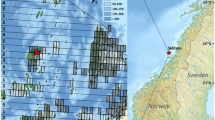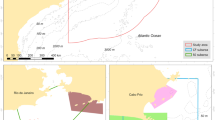Abstract
Shellfish farming is an expanding segment of marine aquaculture, but the impact of this industry on coastal cetacean species is only beginning to be considered. The interaction between mussel farming and coastal cetaceans in one of the world’s leading producers of this bivalve (Galicia, NW Spain) was studied. Specifically, the habitat use of common bottlenose dolphins (Tursiops truncatus) was evaluated in relation to environmental, geographical, and anthropogenic variables. Over a period of 22 months spent in the field, 154 daily boat surveys and 353 common bottlenose dolphin encounters were done. Results of this study confirm that areas of mussel production are frequently utilized by common bottlenose dolphins. Of the investigated factors, shellfish farms appeared to have a clear effect, with increased bottlenose dolphin occurrence at mussel farm locations and in waters close to the aquaculture zones. These observations contrast with previous studies where the occurrence and distribution of coastal cetacean species decreased in association with shellfish aquaculture representing a source of habitat loss and causing potentially negative effects. These differences suggest that the interactions between shellfish aquaculture and cetaceans are affected by the culture method and cetacean species involved. The positive relationships between dolphins’ occurrence and mussel aquaculture zones are presumably the result of large aggregations of fish species around mussel rafts, which provide high densities of high-quality prey for dolphins. This study provides new insights into the understanding of how shellfish aquaculture influences coastal dolphins and hence support the design of policies aimed at implementing ecosystem management principles.




Similar content being viewed by others
References
Altmann J (1974) Observational study of behavior: sampling methods. Behaviour 49:227–267
Alvarez I, Decastro M, Gomez-Gesteira M, Prego R (2005) Inter- and intra-annual analysis of the salinity and temperature evolution in the Galician Rías Baixas–ocean boundary (northwest Spain). J Geophys Res: Oceans 110 (C4)
Araújo MB, New M (2007) Ensemble forecasting of species distributions. Trends Ecol Evol 22(1):42–47.
Bearzi G, Fortuna CM, Reeves RR (2008) Ecology and conservation of common bottlenose dolphins Tursiops truncatus in the Mediterranean Sea. Mamm Rev 39(2):92–123.
Bonizzoni S, Furey NB, Pirotta E, Valavanis VD, Würsig B, Bearzi G (2014) Fish farming and its appeal to common bottlenose dolphins: modelling habitat use in a Mediterranean embayment. Aquat Conserv Marine Freshw Ecosyst 24(5):696–711
Bostock J, McAndrew B, Richards R, Jauncey K, Telfer T, Lorenzen K, Little D, Ross L, Handisyde N, Gatward I, Corner R (2010) Aquaculture: global status and trends. Philos Trans R Soc B: Biol Sci 365(1554):2897–2912
Chesney EJ, Iglesias J (1979) Seasonal distribution, abundance and diversity of demersal fishes in the inner Ria de Arosa, northwest Spain. Estuar Coast Mar Sci 8(3):227–239
Diaz Lopez B, Addis A, Fabiano F (2013) Ecology of bottlenose dolphins along the north-western Sardinian coastal waters (Italy). Thalassas 29(2):35–44.
Díaz López B (2006a) Interactions between Mediterranean bottlenose dolphins (Tursiops truncatus) and gillnets off Sardinia, Italy. ICES J Marine Sci 63:946–951.
Díaz López B (2006b) Bottlenose dolphin (Tursiops truncatus) predation on a marine fin fish farm: some underwater observations. Aquat Mamm 32:305–310.
Díaz López B (2012) Bottlenose dolphins and aquaculture: interaction and site fidelity on the north-eastern coast of Sardinia (Italy). Marine Biol 159:2161–2172
Díaz López B (2017) Temporal variability in predator presence around a fin fish farm in the Northwestern Mediterranean Sea. Marine Ecol 38(1):e12378
Díaz López B, Shirai JAB (2007) Bottlenose dolphin (Tursiops truncatus) presence and incidental capture in a marine fish farm on the north-eastern coast of Sardinia (Italy). J Marine Biol Assoc UK 87:113–117
Díaz López B, Shirai JAB (2008) Marine aquaculture and bottlenose dolphins’ (Tursiops truncatus) social structure. Behav Ecol Sociobiol 62(6):887–894
Díaz López B, Marini L, Polo F (2005) The impact of a fish farm on a bottlenose dolphin population in the Mediterranean Sea. Thalassas 21:53–58.
Dormann CF, Elith J, Bacher S, Buchmann C, Carl G, Carré G, Marquéz JRG, Gruber B, Lafourcade B, Leitão PJ, Münkemüller T (2013) Collinearity: a review of methods to deal with it and a simulation study evaluating their performance. Ecography 36(1):27–46
Evans G, Prego R (2003) Rias, estuaries and incised valleys: is a ria an estuary? Marine Geol 196(3):171–175
F.A.O. (2014) The state of world fisheries and aquaculture: opportunities and challenges. Food and Agriculture Organization of the United Nations, Rome
Fuentes J, Gregorio V, Giráldez R, Molares J (2000) Within-raft variability of the growth rate of mussels, Mytilus galloprovincialis, cultivated in the Ría de Arousa (NW Spain). Aquaculture 189(1):39–52
Hastie TJ, Tibshirani RJ (1990) Generalised additive models. Monographs on statistics and applied probabilities, vol 46. Chapman & Hall, London
Iwama GK (1991) Interactions between aquaculture and the environment. Crit Rev Environ Control 21(2):177–216
Jefferson TA, Hung SK (2004) A review of the status of the Indo-Pacific humpback dolphin (Sousa chinensis) in Chinese waters. Aquat Mamm 30(1):149–158.
Louis M, Viricel A, Lucas T, Peltier H, Alfonsi A, Berrow S, Brownlow A, Covelo P, Dabin W, Deaville R, de Stephanis R, Gally F, Gauffier P, Penrose R, Silva M, Guinet C, Simon-Bohuet B (2014) Habitat-driven population structure of bottlenose dolphins, Tursiops truncatus, in the North-East Atlantic. Mol Ecol 23(4):857–874
Mann J, Smuts BB (1998) Natal attraction: allomaternal care and mother–infant separations in wild bottlenose dolphins. Anim Behav 55(5):1097–1113
Mann J, Connor RC, Barre LM, Heithaus MR (2000) Female reproductive success in bottlenose dolphins (Tursiops sp.): life history, habitat, provisioning, and group-size effects. Behav Ecol 11(2):210–219
Markowitz TM, Harlin AD, Würsig B, McFadden CJ (2004) Dusky dolphin foraging habitat: overlap with aquaculture in New Zealand. Aquat Conserv Marine Freshw Ecosyst 14(2):133–149.
McKindsey CW, Archambault P, Callier MD, Olivier F (2011) Influence of suspended and off-bottom mussel culture on the sea bottom and benthic habitats: a review. Can J Zool 89(7):622–646
Miguez GC, Gil MDG, Lafuente MMV (2009) The institutional foundations of economic performance of mussel production: The Spanish case of the Galician floating raft culture. Marine Policy 33(2):288–296
Naylor RL, Goldburg RJ, Primavera JH, Kautsky N, Beveridge MC, Clay J, Folke C, Lubchenco J, Mooney H, Troell M (2000) Effect of aquaculture on world fish supplies. Nature 405(6790):1017–1024
Neter J, Wasserman W, Kutner MH (1990) Applied linear models, regression, analysis of variance and experimental designs. RD Irwin, Boston
Pan W (2001) Akaike’s information criterion in generalized estimating equations. Biometrics 57:120–125
Pearson HC (2009) Influences on dusky dolphin (Lagenorhynchus obscurus) fission-fusion dynamics in Admiralty Bay, New Zealand. Behav Ecol Sociobiol 63(10):1437–1446
Pearson HC, Vaughn-Hirshorn RL, Srinivasan M, Würsig B (2012) Avoidance of mussel farms by dusky dolphins (Lagenorhynchus obscurus) in New Zealand. NZ J Mar Freshwat Res 46(4):567–574
Perez Camacho A, Gonzalez G, Fuentes J (1991) Mussel culture in Galicia (N.W. Spain). Aquaculture 94:263–278
Pierce GJ, Caldas M, Cedeira J, Santos MB, Llavona A, Covelo P, Martinez G, Torres J, Sacau M, López A (2010) Trends in cetacean sightings along the Galician coast, north-west Spain, 2003–2007, and inferences about cetacean habitat preferences. J Marine Biol Assoc UK 90(Special issue 08):1547–1560
Pillay TVR (2008) Aquaculture and the environment. Wiley, New York
Pirotta E, Matthiopoulos J, MacKenzie M, Scott-Hayward L, Rendell L (2011) Modelling sperm whale habitat preference: a novel approach combining transect and follow data. Mar Ecol Prog Ser 436:257–272
Planque B, Loots C, Petitgas P, Lindstrøm ULF, Vaz S (2011) Understanding what controls the spatial distribution of fish populations using a multi -model approach. Fish Oceanogr 20(1):1–17
Prego R, del Carmen Barciela M, Varela M (1999) Nutrient dynamics in the Galician coastal area (Northwestern Iberian Peninsula): do the Rias Bajas receive more nutrient salts than the Rias Altas? Cont Shelf Res 19(3):317–334
Price IM, Nickum JG (1995) Aquaculture and birds: the context for controversy. Colonial Waterbirds 18:33–45.
Ribeiro S, Viddi FA, Cordeiro JL, Freitas TR (2007) Fine-scale habitat selection of Chilean dolphins (Cephalorhynchus eutropia): interactions with aquaculture activities in southern Chiloé Island, Chile. J Marine Biol Assoc UK 87(01):119–128
Rodríguez GR, Villasante S, do Carme García-Negro M (2011) Are red tides affecting economically the commercialization of the Galician (NW Spain) mussel farming? Marine Policy 35(2):252–257
Rountree RA (1989) Association of fishes with fish aggregation devices: effects of structure size on fish abundance. Bull Mar Sci 44(2):960–972
Santos MB, Fernández R, López A, Martínez JA, Pierce GJ (2007) Variability in the diet of bottlenose dolphin, Tursiops truncatus, in Galician waters, north-western Spain, 1990–2005. J Mar Biol Assoc UK 87(01):231–241
Scott MD, Wells RS, Irvine AB (1990) A long-term study of bottlenose dolphins on the west coast of Florida. In: Leatherwood S, Reeves RR (eds) The bottlenose dolphin. Academic Press, New York, pp 235–244
Stevick PT, McConnell BJ, Hammond PS (2009) Patterns of movement. In: Rus Hoelzel A (ed) Marine mammal biology: An evolutionary approach, Wiley, UK, pp 185–216
Watson-Capps JJ, Mann J (2005) The effects of aquaculture on bottlenose dolphin (Tursiops sp .) ranging in Shark Bay, Western Australia. Biol Conserv 124(4):519–526
Wood SN (2006) Generalized additive models, an introduction with R. Chapman & Hall/CRC, London
Würsig B, Gailey GA (2002) Marine mammals and aquaculture: conflicts and potential resolutions. In: Stickney RR, McVay JP (eds) Responsible marine aquaculture. CAP International Press, New York, pp 45–59
R Development Core Team (2012) R: a language and environment for statistical computing. R Foundation for Statistical Computing, Vienna, Austria. http://www.R-project.org/ [30th July 2016].
López A (2003) Estatus dos pequenos cetáceos da plataforma de Galicia.PhD Thesis. Universidade de Santiago de Compostela, Spain. 337pp
Visser IN (2007) Killer whales in New Zealand waters: status and distribution with comments on foraging. Unpublished report (SC/59/SM19) to the Scientific Committee, International Whaling Commission
Acknowledgements
Field observations carried out during this work are part of a long-term study supported by funding from the Bottlenose Dolphin Research Institute (BDRI). We would like to thank the BDRI students and volunteers who assisted with fieldwork. Many thanks are also extended to Niki Karagouni and Victoria Hope who generously gave their time to help with field and laboratory work.
Funding
This study was funded by the Bottlenose Dolphin Research Institute BDRI.
Author information
Authors and Affiliations
Corresponding author
Ethics declarations
Conflict of interest
Both authors of this study declare that they have no conflict of interest.
Additional information
Communicated by U. Siebert.
Reviewed by Undisclosed experts.
Rights and permissions
About this article
Cite this article
Díaz López, B., Methion, S. The impact of shellfish farming on common bottlenose dolphins’ use of habitat. Mar Biol 164, 83 (2017). https://doi.org/10.1007/s00227-017-3125-x
Received:
Accepted:
Published:
DOI: https://doi.org/10.1007/s00227-017-3125-x




